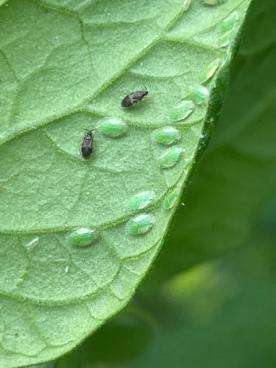Integrated Pest Management (IPM)

TomatoesNZ has been supporting a project into different biological pest management strategies since August 2021. These trials have been part funded by MPI through A Lighter Touch.
Why was this research needed?
When Tomato Potato Psyllid (TPP) was first detected in New Zealand in 2006, growers who had been using beneficial insects to manage common greenhouse pests, turned to chemicals as they didn't have a biological control option to manage TPP. In time, growers reported that the existing chemical options were not giving the same results as they had and new chemicals weren't coming on to the market to try. Emiliano Veronesi found good results from using Engytatus in lab based trials with TPP but this needed to be tested in commercial greenhouses.
Around 7 commercial greenhouses were part of the trials that began at the end of 2022 and the lessons learnt have been communicated through workshops. The commercial trials have extended to other common greenhouse pests with a focus for the first 12 months on whitefly. As the growers weren't using chemicals to control TPP or whitefly, other pests also needed to have biological controls put in place.
But beneficial insects are only one aspect of Integrated Pest Management. As part of the project, we have looked at residues of various off-label products with a whitefly claim, the effect that different activates have on beneficial insects, other biological and mechanical controls.
For the duration of the project, tips and tricks have been gathered. These include:
- Contact your BCA supplier when you order your seeds. The earlier the BCAs are introduced, the better the impact
- Tell your nursery that you plan to use BCAs. Chemical use on your plants can then be tailored accordingly
- Time your BCAs to arrive with your new seedlings
- Supplementary feeding will be required when pest numbers are low but will allow BCA populations to become established before they're required
- Scouting for pests will allow you to understand the number and distribution of pests and BCAs. If trained on what they need to look for, all staff members will provide an extra pair of eyes
- Growers shouldn't look to fully eliminate the target pests, rather keep them under control so they aren't damaging your crop
- Hotspots of pests might occur from time to time. Talk to your BCA supplier about how best to treat these.
- Make sure holes and cracks in your greenhouse are repaired so that pests can't enter this way
- As this is a natural process there might be some hiccups but these can be managed without turning to chemicals
- If you have issues, phone your BCA supplier as they can talk through how best to manage hot spots of pests
- Sometimes patience is required!
To help growers on a day to day basis, we have developed a series of written and video resources. The videos are all on YouTube here. The written resources can be downloaded below. If you would like a hard copy of the written resources, please get in touch info@tomatoesnz.co.nz
To view the IPM videos on this link, click here
